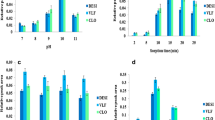ABSTRACT
Purpose
Contrary to physical characterization techniques for nanopharmaceuticals (shape, size and zeta-potential), the techniques to quantify the free and the entrapped drug remain very few and difficult to transpose in routine analytical laboratories. The application of Solid Phase Extraction (SPE) technique was investigated to overcome this challenge.
Methods
The separation of free and entrapped drug by SPE was quantitatively validated by High Performance Liquid Chromatography. The developed protocol was implemented to characterize cyclosporine A-loaded 120 nm-sized lipid nanoparticles (LNPs, Lipidot®) dispersed in aqueous buffer. The colloidal stability was assessed by Dynamic Light Scattering (DLS).
Results
Validation experiments demonstrated suitable linearity, repeatability, accuracy and specificity to quantify residual free, entrapped and total drug. For the investigated LNPs, the method revealed a very limited shelflife of the formulation when stored in an aqueous buffer at 5°C and even more at elevated temperature. Nevertheless, the DLS measurements confirmed the stability of nanoparticles during SPE in a suitable concentration range.
Conclusions
SPE, when successfully validated, represents a valuable tool for drug development and quality control purposes of lipid-based nanopharmaceuticals in an industrial environment.




Similar content being viewed by others
Abbreviations
- ACN:
-
Acetonitrile
- API:
-
Active pharmaceutical ingredient
- CSA:
-
Cyclosporine A
- CV:
-
Coefficient of variation
- DAD:
-
Diode Array Detector
- DLS:
-
Dynamic Light Scattering
- EDCD:
-
Entrapped Drug Content Determination
- F0:
-
Fraction 0
- F1:
-
Fraction 1
- F2:
-
Fraction 2
- FDCD:
-
Free Drug Content Determination
- HPLC:
-
High Performance Liquid Chromatographie
- ICH:
-
International Conference on Harmonisation of Technical Requirements for Registration of Pharmaceuticals for Human Use
- LNP:
-
Lipid nanoparticle
- LOD:
-
Limit of Detection
- LOQ:
-
Limit of Quantification
- MeOH:
-
Methanol
- MWCO:
-
Molecular Weight Cut-Off
- n. a.:
-
Not available/not applicable
- NP:
-
Nanoparticle
- PBS:
-
Phosphate Buffered Saline
- PdI:
-
Polydispersity Index
- PEG:
-
Polyethylene Glycol
- R2 :
-
Determination coefficient
- RP:
-
Reverse Phase
- rpm:
-
Revolutions per minute
- RSD:
-
Relative Standard Deviation
- SPE:
-
Solid Phase Extraction
- TDCD:
-
Total Drug Content Determination
- TFA:
-
Trifluoroacetic acid 0.5% (v/v)
REFERENCES
Venditto VJ, Szoka Jr FC. Cancer nanomedicines: so many papers and so few drugs! Adv Drug Deliv Rev. 2013;65(1):80–8.
Crist RM, Grossman JH, Patri AK, Stern ST, Dobrovolskaia MA, Adiseshaiah PP, et al. Common pitfalls in nanotechnology: lessons learned from NCI’s Nanotechnology Characterization Laboratory. Integr Biol. 2013;5(1):66–73.
Shah RB, Khan MA. Nanopharmaceuticals: challenges and regulatory perspective. In: De Villiers MM, Aramwit P, Kwon GS, editors. Nanotechnology in Drug Delivery; 2009. p. 627.
Modi S, Anderson BD. Determination of drug release kinetics from nanoparticles: overcoming pitfalls of the dynamic dialysis method. Mol Pharm. 2013;10(8):3076–89.
Lopez-Serrano A, Olivas RM, Landaluze JS, Camara C. Nanoparticles: a global vision. Characterization, separation, and quantification methods. Potential environmental and health impact. Anal Methods. 2014;6(1):38–56.
Magenheim B, Levy MY, Benita S. A new in vitro technique for the evaluation of drug release profile from colloidal carriers—ultrafiltration technique at low pressure. Int J Pharm. 1993;94(1–3):115–23.
Wallace SJ, Li J, Nation RL, Boyd BJ. Drug release from nanomedicines: selection of appropriate encapsulation and release methodology. Drug Deliv Transl Res. 2012;2(4):284–92.
Ohnishi N, Yamamoto E, Tomida H, Hyodo K, Ishihara H, Kikuchi H, et al. Rapid determination of the encapsulation efficiency of a liposome formulation using column-switching HPLC. Int J Pharm. 2013;441(1–2):67–74.
Griese N, Blaschke G, Boos J, Hempel G. Determination of free and liposome-associated daunorubicin and daunorubicinol in plasma by capillary electrophoresis. J Chromatogr A. 2002;979(1–2):379–88.
Bibette J, Goutayer M, Texier-Nogues I, inventors; Commissariat à l’Energie Atomique, assignee. Method for preparing nano-emulsions patent WO2008104717 (A2). 2008.
U. S. Food and Drug Administration. Guideline for Industry: Text on Validation of Analytical Procedures : ICH-Q2A: U.S. Department of Health and Human Services, Public Health Service, Food and Drug Administration; 1995.
Delmas T, Piraux H, Couffin A-C, Texier I, Vinet F, Poulin P, et al. How to prepare and stabilize very small nanoemulsions. Langmuir. 2011;27(5):1683–92.
Delmas T, Fraichard A, Bayle P-A, Texier I, Bardet M, Baudry J, et al. Encapsulation and release behavior from lipid nanoparticles: model study with Nile red fluorophore. J Colloid Sci Biotechnol. 2012;1(1):16–25.
ACKNOWLEDGMENTS AND DISCLOSURES
This work was sponsored by the German Federal Ministry of Education and Research and financially supported by the EuroNanoMed Project Delivering Nanopharmaceuticals through Biological Barriers ‘BiBa’ (ERA-Net EuroNanoMed Project Number 13N11846).
The authors thank Christina Draheim for performing the DLS preliminary tests and Johannes Krämer for providing the facility and equipment necessary for the investigations.
Author information
Authors and Affiliations
Corresponding author
Rights and permissions
About this article
Cite this article
Guillot, A., Couffin, AC., Sejean, X. et al. Solid Phase Extraction as an Innovative Separation Method for Measuring Free and Entrapped Drug in Lipid Nanoparticles. Pharm Res 32, 3999–4009 (2015). https://doi.org/10.1007/s11095-015-1761-8
Received:
Accepted:
Published:
Issue Date:
DOI: https://doi.org/10.1007/s11095-015-1761-8




